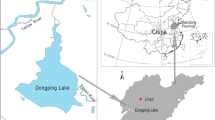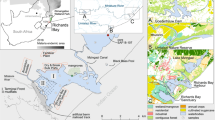Abstract
The nine organochlorine pesticides (OCPs) in the sediment samples taken from Gwangyang Bay, which is a heavy chemical industrial region in South Korea, are analyzed to evaluate their contaminations during the past 50 years. The vertical distributions of ΣOCPs concentration in the sediment core were in good agreement with the temporal amount of pesticides used in South Korea except for the top sediment layer. The DDTs were predominant, their concentrations ranging from 78.0 to 202 pg/g dry wt and attributed more than 60% to ΣOCPs in all the sediment layers. Based on the ratio of DDT metabolite compositions, the DDT contamination in the top layer might be caused from recent input. This is due to the highest residual concentration of OCPs in the top layer. Although HCB and mirex have been unregistered as pesticides in South Korea, two compounds were detectable in all of the sediment samples in the range from 0.243 to 16.7 pg/g dry wt in the study area. The emission source of HCB in the sediment core could be estimated to be due to incomplete combustion in the industrial chemical processes rather than pesticide application. Regarding horizontal distribution of ΣOCPs, the concentration was slightly higher than for the inner bay than the outer bay. The OCPs in the sediments of Gwangyang Bay were compared with those of other countries by hierarchical cluster analysis and principal component analysis.





Similar content being viewed by others
References
Adhikari DP, Kumon F (2001) Climatic changes during the past 1300 years as deduced from the sediments of lake Nakatsuna, central Japan. Limnology 2:157–168
Barra R, Cisternas M, Urruita R, Pozo K, Pacheco P, Parra O, Focardi S (2001) First report on chlorinate pesticide deposition in a sediment core from a small lake in central Chile. Chemosphere 45:749–757
Cho H-S, Kim Y-O, Shin T-S, Horiguchi T (2004) A study on the pollution of bisphenol A in surface sediment around Gwangyang Bay. J Korean Soc Marine Environ Eng 7:104–110
Choi D, Kwon O, Eun H, Hong S, Kim Y, Kwon H, Choi J (2006) Analysis of POPs using HRGC-HRMS in cultural soils of Korea. Organiohalogen Compounds 68:1026–1028
Hirai Y, Kato T, Takatsuki H, Sakai S (2001) Simulation of historical trend of hexachlorobenzene in sediment cores using the emission estimate and dynamic multimedia environmental fate model. J Environ Chem 11:793–804
Hong SH, Yim UH, Shim WJ, Oh JR, Lee IS (2003) Horizontal and vertical distribution of PCBs and chlorinated pesticides in sediments from Masan Bay, Korea. Marine Pollut Bull 46:244–253
Hong SH, Yim UH, Shim WJ, Oh JR (2005) Congener-specific survey for polychlorinated biphenlys in sediments of industrialized bays in Korea: regional characteristics and pollution sources. Environ Sci Technol 39:7380–7388
Hong SH, Yim UH, Shim WJ, Li DH, Oh JR (2006) Nationwide monitoring of polychlorinated biphenyls and organochlorine pesticides in sediments from coastal environment of Korea. Chemosphere 64:1479–1488
Imanishi K, Kawakami M, Shimada A, Chikaishi K, Kimura Y, Kajiwara N, Yamada T, Tanabe S (2004) Detection of pesticides unregistered in Japan, Toxaphene and Mirex, in the cetaceans from Japanese coastal waters. Organiohalogen Compounds 66:1527–1532
Iwata H, Tanabe S, Sakai N, Tatsukawa R (1993) Distribution of persistent organochlorines in the oceanic air and surface seawater and the role of ocean on their global transport and fate. Environ Sci Technol 27:1080–1098
Kannan K, Tanabe S, Tatsukawa R (1995) Geographical and accumulation features of organochlorine residues in fish in tropical Asia and Oceania. Environ Sci Technol 29:2673–2683
Khim JS, Kannan K, Villeneuve DL, Koh C-H, Giesy JP (1999) Characterization and distribution of trace organic contaminants in sediment from Masan Bay, Korea. 1. Instrumental analysis. Environ Sci Technol 33:4199–4205
Khim JS, Lee KT, Kannan K, Villeneuve DL, Giesy JP, Koh C-H (2001) Trace organic contaminants in sediment and water from Ulsan Bay and its vicinity, Korea. Arch Environ Contam Toxicol 40:141–150
Kim J-H, Smith A (2001) Distribution of organochlorine pesticides in soils from South Korea. Chemosphere 43:137–140
Kim Y-S, Eun H, Katase T, Fujiwara H (2007) Vertical distributions of persistent organic pollutants (POPs) caused from organochlorine pesticides in a sediment core taken from Ariake Bay, Japan. Chemosphere 67:456–463
Koh CH, Khim JS, Villeneuve DL, Kannan K, Giesy JP (2002) Analysis of trace organic contaminants in sediment, pour water, and water samples from Onsan Bay, Korea: instrumental analysis and in vitro gene expression assay. Environ Toxicol Chem 21:1796–1803
Koh CH, Khim JS, Villeneuve DL, Kannan K, Giesy JP (2006) Characterization of trace organic contaminants in marine sediment from Yeongil Bay, Korea: 1. Instrumental analyses. Environ Pollut 142:39–47
Korea Maritime Institute (2004) Expert workshop for estimation of environmental status in environmental protection region, Gwangyang Bay. Available from http://www.kmi.re.kr/data/seminar/20040820.pdf
Korea Ocean Research and Development Institute (2003) A study on the management model for environmental pollution of special management area in Namhae: (I) Gwangyang Bay study. Available from http://www.mera.kordi.re.kr/gy/PDF/00.pdf
Kumar KS, Watanabe K, Takemori H, Iseki N, Masunaga S, Takasuga T (2005) Analysis of UNEP priority POPs using HRGC-HRMS and their contamination profiles in livers and eggs of Great Cormorants (Phalacrocorax carbo) from Japan. Arch Environ Contam Toxicol 48:538–551
Lammel G, Ghim Y-S, Grados A, Gao H, Hühnerfuss H, Lohmann R (2007) Levels of persistent organic pollutants in air in China and over the Yellow Sea. Atmos Environ 41:452–464
Lee KT, Tanabe S, Koh CH (2001) Distribution of organochlorine pesticides in sediments from Kyeonggi Bay and nearby areas, Korea. Environ Pollut 114:207–213
Loganathan BG, Kannan K (1994) Global organochlorine contamination trends: an overview. Ambio 23:187–191
Masunaga S, Takasuga T, Nakanishi J (2001) Dioxin and dioxin-like PCB impurities in some Japanese agrochemical formulations. Chemosphere 44:873–885
Moon H-B, Choi H-G, Kim S-S, Lee S-J, Lee P-Y, Ok G (2003) Evaluation of PCDDs/DFs origin in marine sediments from the industrialised regions of Korea. Organohalogen Compounds 65:60–65
Nakata H, Hirakawaa Y, Kawazoea M, Nakabob T, Arizonoc K, Abea S-I, Kitanoa T, Shimadad H, Watanabee I, Lif W, Ding X (2005) Concentrations and compositions of organochlorine contaminants in sediments, soils, crustaceans, fishes and birds collected from Lake Tai, Hangzhou Bay and Shanghai city region, China. Environ Pollut 133:415–429
Oh JR, Choi HK, Hong SH, Yim UH, Shim WJ, Kannan N (2005) A preliminary report of persistent organochlorine pollutants in the Yellow Sea. Marine Pollut Bull 50:217–222
Peng X, Zhang G, Zheng L, Mai B, Zeng S (2005) The vertical variations of hydrocarbon pollutants and organochlorine pesticide residues in a sediment core in Lake Taihu, East China. Geochemistry: Explor Environ Anal 5:99–104
PRC (POPs Research Center) (2005) China POPs Network. POPs-INCHINA. 5 POPs still produced and used in country. Available from http://www.china-pops.net/ENGLISH/index.htm
Wania F, Mackay D (1996) Tracking the distribution of persistent organic pollutants. Environ Sci Technol 30:390A–396A
Wong MH, Leung AOW, Chan JKY, Choi MPK (2005) A review on the usage of POP pesticides in China, with emphasis on DDT loadings in human milk. Chemosphere 60:740–752
Yang RQ, Lv AH, Shi JB, Jiang GB (2005) The levels and distribution of organochlorine pesticides (OCPs) in sediments from the Haihe River, China. Chemosphere 61:347–354
Zhang Z, Dai M, Hong H, Zhou LJ, Yu G (2002) Dissolved insecticides and polychlorinated biphenyls in the Pearl River estuary and South China Sea. J Environ Monit 4:922–928
Zhang ZL, Hong HS, Zhou JL, Huang J, Yu G (2003) Fate and assessment of persistent organic pollutants in water and sediment from Minjiang River Estuary, Southeast China. Chemosphere 52:1423–1430
Acknowledgments
This study was supported by the Japanese Society of the Promotion of Science (JSPS), Tokyo, Japan. The authors also express thanks to their students (Chonnam National University, South Korea) for collecting and preparing sediment core samples with them in South Korea. The authors thank Ms. Emiko Iizumi and Ms. Reiko Nigorikawa (National Institute for Agro-Environmental Sciences) for experimental assistance. The authors are thankful to James J. Berger (The Quest English Language Institute, Japan) for his kind discussions.
Author information
Authors and Affiliations
Corresponding author
Rights and permissions
About this article
Cite this article
Kim, YS., Eun, H., Cho, HS. et al. Organochlorine Pesticides in the Sediment Core of Gwangyang Bay, South Korea. Arch Environ Contam Toxicol 54, 386–394 (2008). https://doi.org/10.1007/s00244-007-9047-8
Published:
Issue Date:
DOI: https://doi.org/10.1007/s00244-007-9047-8




